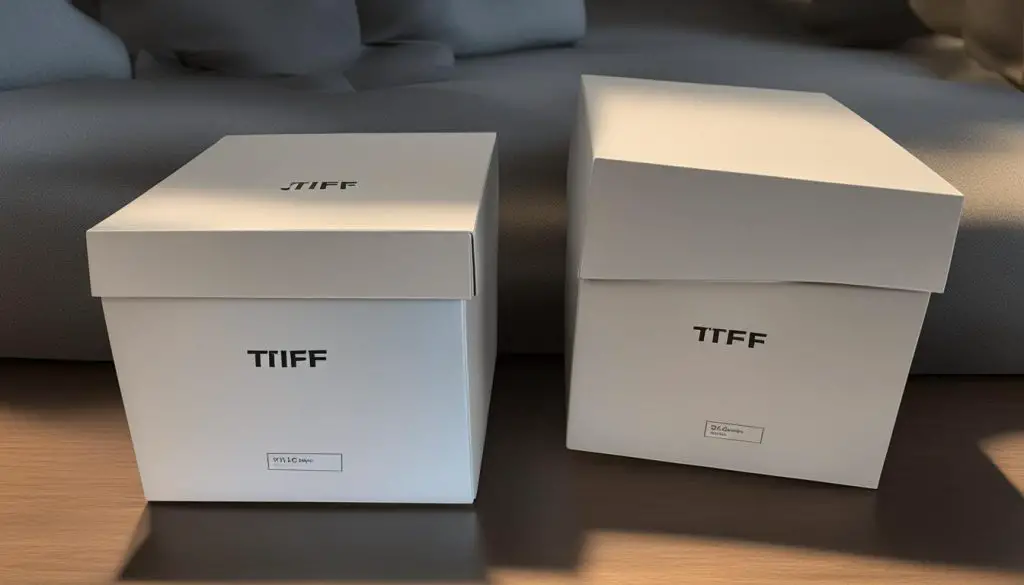TIFF and JPEG are two popular image file formats with important differences. While both formats have their advantages and use cases, understanding their distinctions can help you make informed decisions about which format to use for your specific needs.

Key Takeaways:
- TIFF and JPEG are image file formats with different compression methods.
- JPEGs use lossy compression, resulting in smaller file sizes but a reduction in picture quality.
- TIFFs use lossless compression, retaining all image data but resulting in larger file sizes.
- TIFFs are preferred for digital editing work and as source images, while JPEGs are more suitable for finalized images ready for export and online use.
- The choice between TIFF and JPEG depends on factors such as image quality, storage space, and intended use.
Compression and File Size
When comparing JPEG and TIFF image file formats, it is important to understand the differences in compression and file size. JPEGs use lossy compression, which reduces file sizes but also results in a loss of picture quality. This makes JPEGs ideal for storing, sharing, and emailing images where file size is a priority. In contrast, TIFFs utilize lossless compression, preserving all image data but resulting in larger file sizes.
TIFFs are widely preferred for digital editing work due to their high quality and the ability to retain all image details. They are commonly used as source images, providing flexibility during the editing process. On the other hand, JPEGs are more suitable for finalized images ready for export and online use, thanks to their smaller file sizes and wider compatibility.
Compression Comparison
| JPEG | TIFF | |
|---|---|---|
| Compression Type | Lossy | Lossless |
| Picture Quality | Reduced | Preserved |
| File Size | Smaller | Larger |
| Usage | Storing, sharing, and emailing images | Digital editing and source images |
| Compatibility | Widely compatible | Potential compatibility issues due to larger file sizes |
While JPEGs may sacrifice some image quality through compression, they offer smaller file sizes and greater compatibility across a range of devices and platforms. TIFFs, however, preserve image details and provide higher quality, making them ideal for professional editing projects that require the utmost precision and clarity.
Usage and Transparency
When it comes to comparing TIFF and JPEG image file formats, it is important to consider their usage and transparency capabilities. TIFF files are commonly used as source images for editing purposes. They offer higher resolution and the ability to retain more picture data, making them ideal for professional editing work. In contrast, JPEG files are more suitable for finalizing images and preparing them for export, client delivery, or website posting.
One key advantage of TIFF files is their higher resolution, which allows for more flexibility during the editing process. This higher resolution ensures that all image details are retained, resulting in higher-quality edits. On the other hand, JPEG files, due to their lossy compression, may lose some image data during the editing process, potentially leading to a decrease in image quality.
Another important aspect to consider is transparency. TIFF files support transparent image elements, such as logos or watermarks, that can be added during the editing process. This is particularly useful for designers and photographers who need to add overlays or copyright information to their images. JPEG files, however, do not support transparency, limiting their use in such scenarios.
While both TIFF and JPEG formats are widely compatible with various software and operating systems, it’s worth noting that TIFF files, due to their larger file sizes, may face compatibility issues when it comes to printing and scanning. This is something to consider if you plan on using TIFF files for physical prints or scanning purposes.
Comparing TIFF and JPEG File Formats
| Aspect | TIFF | JPEG |
|---|---|---|
| Compression Type | Lossless | Lossy |
| Image Quality | High, retains all image details | Lower, potential loss of image data |
| Transparent Support | Yes | No |
| Compatibility | May face issues with printing and scanning due to larger file sizes | Widely compatible |
Based on these factors, it is evident that TIFF files are better suited for editing and retaining image quality, while JPEG files are more suitable for finalizing and online use. The choice between the two formats ultimately depends on the specific needs and requirements of the project at hand.
Artefacts and Websites
One significant disadvantage of JPEGs is the appearance of artifacts, which are pixelation or blocky elements that occur when a file loses data through compression. These artifacts can detract from the overall image quality and can be particularly noticeable in areas with fine details, gradients, or high contrast. While JPEG compression helps reduce file sizes, it also sacrifices some image data, resulting in artifacts.
In contrast, TIFFs, being lossless files, do not produce artifacts. This is because lossless compression retains all image data, preserving the original quality and ensuring that no data is lost during the compression process. As a result, TIFFs are often preferred for situations where image fidelity and accuracy are crucial, such as professional graphic design or printing.
“JPEG artifacts can greatly impact the visual appeal of an image, especially in professional settings. When working with high-quality images for print or digital media, it is important to consider the potential for artifacts and to choose a file format, like TIFF, that can maintain the integrity of the image data.”
When it comes to websites, JPEGs are more commonly used due to their smaller file sizes, which help reduce page load times. Websites often require multiple images to be displayed simultaneously, and smaller file sizes provide a faster user experience. Additionally, JPEGs are widely supported by web browsers and platforms, ensuring compatibility across various devices and screen sizes.

Table: JPEG vs. TIFF for Website Design
| Aspect | JPEG | TIFF |
|---|---|---|
| File Size | Smaller | Larger |
| Compression | Lossy | Lossless |
| Compatibility | Widely Supported | Potential Compatibility Issues |
| Page Load Times | Faster | Potentially Slower |
Conclusion
After analyzing the differences between TIFF and JPEG file formats, it is clear that both have their own strengths and weaknesses. TIFF files, with their lossless compression, hold more information and offer higher image quality, making them ideal for digital editing work and as source images. On the other hand, JPEG files, with lossy compression, have smaller file sizes and are more compatible for online use and finalizing images for export or website posting.
The choice between TIFF and JPEG depends on individual needs and requirements. If you prioritize image quality and are working on digital editing projects, TIFF is the preferable option. However, if you need smaller file sizes and wide compatibility for sharing or posting images online, JPEG is the more suitable choice.
In summary, TIFF vs. JPEG comparison highlights the trade-off between image quality and file size. TIFFs excel in image quality but have larger file sizes, while JPEGs prioritize smaller files but sacrifice some details. Consider the specific needs of your projects and the intended use of the images to make an informed decision between TIFF and JPEG.
